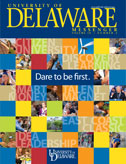The Winterthur Program in American Material Culture takes a trip back in time
Tourists at Colonial Williamsburg get a glimpse of 18th-century life, watching as coopers make oak barrels, blacksmiths pump bellows to feed their coal-fired forge, wheelwrights fit a red-hot iron hoop onto the wheel of a carriage and weavers use plants and even insects to create colorful dyes.
Six UD graduate students who spent three days at the historic site this spring, however, were participants rather than observers.
“It’s a fantastic, immersion type of learning, and it’s extremely hands-on,” says J. Ritchie Garrison, professor of history and director of the graduate Winterthur Program in American Material Culture. “The students have learned about these kinds of trades, but watching it being done is different from listening to a lecture. And, then, actually doing it is entirely different.”
Garrison has been taking a small group to Williamsburg every spring for many years, as a requirement of the “Early American Craftsmanship” course that students in the Winterthur material culture program take. He says the focus of the visit is on the trade shops, especially the kinds of trades that can’t be replicated at Winterthur Museum, and that the artisans at Williamsburg give the group “extraordinary access” that goes far beyond what typical visitors get to see.
“Our students are pumping bellows, casting pewter spoons, participating in the making of sand molds,” he says. “Even though I go each spring, I learn new things myself every year.”
Many University alumni work at Colonial Williamsburg, in the areas of both preservation and conservation. The skilled craftsmen at the site, from master gunsmiths to coopers, are a rarity in today’s world, and Garrison notes that Williamsburg is “one of very few places in the United States where you can see this sort of work.”
This year’s group consisted of four Winterthur fellows, a history doctoral student and a student in the doctoral preservation studies program. Garrison says they were able to see firsthand how painstakingly the Williamsburg site was researched and reconstructed and to appreciate the time and skill that was required to practice a craft in Colonial times.
“Most of us today would starve without modern tools,” he says. “We might be able to learn some of the hand skills required, but we just couldn’t work fast enough to make a living at it.”






